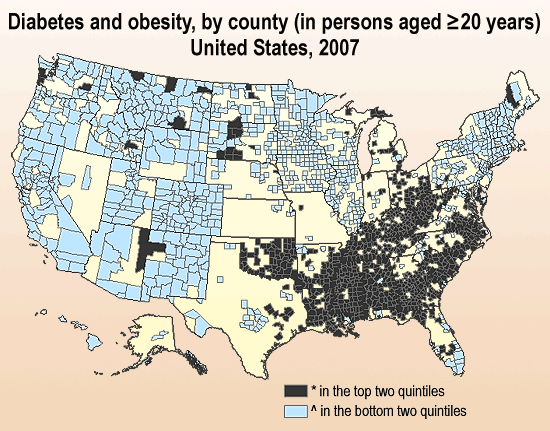The “Diabetes Belt” Shows Concentration Of Disease In U.S. South
 There is such a thing called the “Diabetes Belt,” according to the Centers for Disease Control. The gigantic swath of the southeastern portion of the U.S. starts at the southeastern coast, and runs through Tennessee and Kentucky and stops just at the borders of Texas and north into Oklahoma.
There is such a thing called the “Diabetes Belt,” according to the Centers for Disease Control. The gigantic swath of the southeastern portion of the U.S. starts at the southeastern coast, and runs through Tennessee and Kentucky and stops just at the borders of Texas and north into Oklahoma.
The CDC gave some statistics of rates of diabetes and obesity that are pretty alarming. In the Appalachian region of Kentucky, Tennessee and West Virginia, 81% of the counties have high rates; 77% in the Alabama, Georgia, Louisiana, Mississippi and South Carolina; also some tribal lands in the West and Northern Plains have high rates of obesity and diabetes.
The Los Angeles Times also reported on a study in the American Journal of Preventive Medicine that showed Native Americans in the western part of the country, specifically: Arizona, New Mexico, Montana, Nevada and Washington, also suffered from high rates of the disease. The paper reported:
By no coincidence, there is considerable overlap among these three belts. Much of its is simple demographics: Ethnicity and age are key factors in a person’s risk of developing diabetes. African Americans, who are clustered densely inside the diabetes belt, appear to be predisposed to diabetes and metabolic disturbances, as are American Indians, who largely account for pockets of diabetes scattered throughout the Western states. (Curiously, although Latino descent is considered a risk factor for type-2 diabetes, the map shows little overlap between Latino population clusters and places where the incidence of diabetes is very high.)
But behavior matters too. Two “modifiable risk factors” for diabetes — obesity and sedentary behavior — account for 30% of the difference between counties with a normal or near-normal rate of type-2 diabetes (8.5% of adults) and those with an unusually high rates of diabetes (where roughly 11.7% of adults suffer from the disease). Public health officials should consider “culturally appropriate interventions to decrease obesity and sedentary lifestyle” in the counties of the diabetes belt, the authors urged.
I’d like to also point out that these areas include places that are mostly poor. What’s in the cheap food like soda and chips that we eat? Salt, corn syrup, sugar, preservatives, little fiber and little nutrition. The underlying issue here is poverty; in the U.S., unlike other countries, poor people get fat off the horrible cheap foods available while rich people can eat organic tomatoes. The sad contradiction here is that the U.S. government recommends healthy guidelines for our diets, while not regulating the garbage food manufacturers put into their food.
Which means, of course, it’s up to us to take care of our health.
Follow Sara Inés Calderón on Twitter @SaraChicaD
[Photo By CDC]
